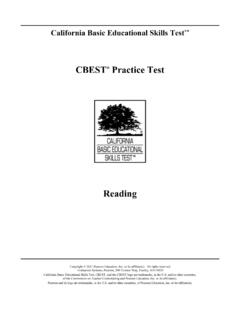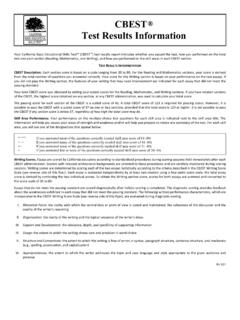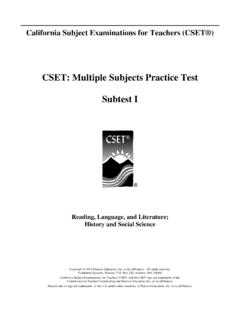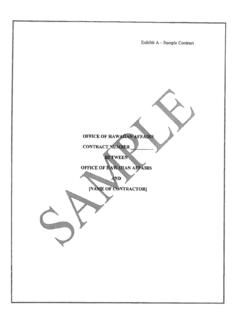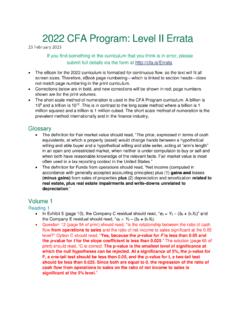Transcription of CSET: Multiple Subjects Practice Test Subtest II
1 California subject Examinations for Teachers (CSET ) CSET: Multiple Subjects Practice Test Subtest II Science; Mathematics Copyright 2017 Pearson Education, Inc. or its affiliate(s). All rights reserved. Evaluation Systems, Pearson, Box 226, Amherst, MA 01004 California subject Examinations for Teachers, CSET, and the CSET logo are trademarks of the Commission on Teacher Credentialing and Pearson Education, Inc. or its affiliate(s). Pearson and its logo are trademarks, in the and/or other countries, of Pearson Education, Inc. or its affiliate(s). Multiple Subjects Practice Test: Subtest II TABLE OF CONTENTS Introduction and Test Directions .. 1 Multiple -Choice Answer Sheet .. 2 Multiple -Choice Questions .. 3 Constructed-Response Directions and Evaluation Recommendations .. 29 Constructed-Response Assignments and Response Sheets.
2 30 Results .. 38 Multiple Subjects Practice Test: Subtest II 1 INTRODUCTION This Practice test is a full-length sample test consisting of 52 Multiple -choice questions and four constructed-response assignments. An answer sheet for the Multiple -choice questions, blank response sheets for the constructed-response assignments, and a Domain Results Worksheet for each domain are also included. TEST DIRECTIONS This Practice test consists of two sections: (1) a Multiple -choice question section and (2) a constructed-response assignment section. Each question in the first section of the Practice test is a Multiple -choice question with four answer choices. Read each question carefully and choose the ONE best answer. Record each answer on the answer sheet provided on page 2. The second section of this Practice test contains constructed-response assignments, which require written responses.
3 Directions for the constructed-response assignments appear immediately before those assignments. You may work on the Multiple -choice questions and constructed-response assignments in any order that you choose. You may wish to monitor how long it takes you to complete the Practice test. When taking the actual CSET: Multiple Subjects , you will have one five-hour test session in which to complete all three subtests. If you register to take just Subtest II, you will have one three-hour session in which to complete the Subtest . Multiple Subjects Practice Test: Subtest II 2 Multiple -CHOICE ANSWER SHEET Science Question Number Your Response 1 2 3 4 5 6 7 8 9 10 11 12 13 14 15 16 17 18 19 20 21 22 23 24 25 26 Mathematics Question Number Your Response 27 28 29 30 31 32 33 34 35 36 37 38 39 40 41 42 43 44 45 46 47 48 49 50 51 52 Multiple Subjects Practice Test: Subtest II 3 Multiple -CHOICE QUESTIONS 1.
4 Which of the following steps in making a cup of coffee involves a chemical change in matter? A. Whole-bean coffee is ground in a coffee grinder. B. A burner on a propane stove is lighted to heat water. C. Water in a kettle begins to boil. D. Boiling water is poured through a filter containing ground coffee. 2. Use the section of the periodic table below to answer the question that follows. (210)Po Which of the elements in the section of the periodic table shown above are likely to have the most similar chemical properties? A. Si and Ge B. C and O C. Sb and Te D. N and S Multiple Subjects Practice Test: Subtest II 4 3. Which of the following liquids is the most acidic and will have the lowest pH? A. milk B. household ammonia C. distilled water D. vinegar 4. Ultraviolet light and visible light are types of radiation that are part of the electromagnetic spectrum.
5 Compared to visible light waves, ultraviolet waves: A. exhibit a longer wavelength. B. have a higher frequency. C. travel at a slower speed. D. have a greater amplitude. 5. Which of the following is the best example of the refraction of light waves? A. Markings on flowers that are invisible in normal light can be seen in ultraviolet light. B. Deep lakes appear to be blue or green in color. C. Sunlight striking a black box will make the box warmer than the same light striking a white box. D. Light passing through raindrops produces a rainbow. 6. Newton's third law of motion states that for every action there is an equal and opposite reaction. Which of the following is the best example of the application of this law? A. More fuel is needed to drive a truck ten miles when it is loaded than when it is unloaded. B. An inflated balloon moves through the air when a jet of air leaves its neck as it deflates.
6 C. Less force is needed to pull a sled over ice than is needed to pull it over sand. D. A passenger in a car continues moving forward when the car stops suddenly. 7. Which of the following examples best demonstrates the difference between thermal energy and temperature? A. A cup of water at 50 C contains less thermal energy than a bathtub full of water at 10 C. B. The same amount of water loses heat faster if it is in a tall, narrow bottle than if it is in a short, wide bottle. C. A dark-colored object gets warmer in the sun than a light-colored object. D. A person feels cooler on a cold day when the wind is blowing. Multiple Subjects Practice Test: Subtest II 5 8. A large round boulder is pushed from the top of a smooth steep hill and rolls to the bottom. Which of the following graphs shows the distance the boulder travels with respect to time as it rolls down the hill?
7 A. B. Time Distance0 0 Time Distance C. D. Time Distance0 0 Time Distance Multiple Subjects Practice Test: Subtest II 6 9. The stems of a bunch of just-cut white flowers are immersed in a container of water to which blue dye has been added. After 24 hours, 2 tablespoons of salt are added to the water. Twenty-four hours later the flowers will most likely appear: A. wilted and light blue. B. fresh and white. C. wilted and white. D. fresh and light blue. 10. Which of the following statements best explains how carbon plays a central role in the functioning of biological systems? A. Carbon actively transports nutrients and wastes across cell membranes. B. Carbon insulates nerves because it has very low electrical conductivity. C. Carbon combines with other elements to form a variety of useful compounds. D. Carbon transports oxygen through the bloodstream to the cells of the body.
8 11. When a seed germinates, its roots will grow down and its shoots will grow up, even if the seed is planted upside down. This downward growth of roots and upward growth of shoots is due to the plant's response to: A. gravity. B. light. C. temperature. D. moisture. 12. Organisms maintain stability in a changing environment by changing themselves. These changes can be detected over time and may occur at different rates. Which of the following examples illustrates an organism accommodating or adjusting to a change in its environment, rather than adapting to environmental changes? A. Rose plants grow thorns on their stems to protect themselves from predators. B. Whales migrate seasonally to warmer waters to mate and give birth. C. Blood vessels in a human body constrict to conserve heat during cold weather. D. Glands in honeysuckle flowers secrete nectar to attract insects and birds as pollinators.
9 Multiple Subjects Practice Test: Subtest II 7 13. Certain species of acacia trees have long hollow thorns that house stinging ants. The ants feed on nectar produced by the tree and attack anything that touches the tree. The relationship between the ants and the acacias is an example of: A. mutualism. B. parasitism. C. commensalism. D. predation. 14. Use the information below to answer the question that follows. The diagram above is a generalized energy pyramid for a freshwater swamp and surrounding forest in a mild, temperate climate. The swamp is dominated by reeds and other swamp grasses, with various shrubs and trees on the higher ground. A large number of animal species, ranging in size from small insects to deer, are present in the swamp and forest. The energy pyramid is narrower at the top than at the bottom because organisms at the higher levels: A.
10 Exploit a narrower range of environmental resources than the organisms at the lower levels. B. are larger and require less energy per unit of body mass than the organisms at the lower levels. C. have less energy available to them than organisms at the lower levels. D. are more efficient at producing energy from sunlight than the organisms at the lower levels. Multiple Subjects Practice Test: Subtest II 8 15. Some species of aphids can reproduce asexually under certain conditions. Female aphids produce other female aphids without being fertilized by a male. This asexual reproduction may continue over many generations during the summer. In late summer or early fall, male aphids are produced and sexual reproduction resumes. Which of the following is most likely to be an advantage to a female aphid asexually reproducing during the summer? A.



